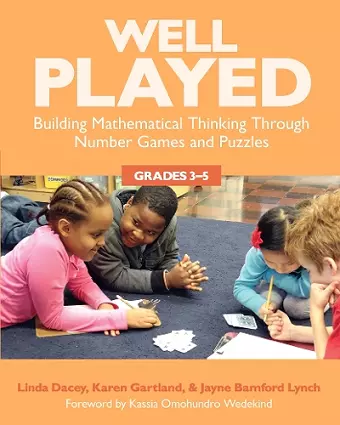Well Played, Grades 3-5
Building Mathematical Thinking Through Number Games and Puzzles
Linda Dacey author Karen Gartland author Jayne Bamford Lynch author
Format:Paperback
Publisher:Taylor & Francis Inc
Published:30th Jun '15
Currently unavailable, and unfortunately no date known when it will be back

Students love math games and puzzles, but how much are they really learning from the experience? Too often, math games are thought of as just a fun activity or enrichment opportunity. Well Played, Grades 3-5: Building Mathematical Thinking Through Number Games and Puzzles shows you how to make games and puzzles an integral learning component that provides teachers with unique access to student thinking. The twenty-five games and puzzles in Well Played, Grades 3-5 which have all been field-tested in diverse classrooms, contain:
- Explanations of the mathematical importance of each game or puzzle and how it supports student learning
- Variations for each game or puzzle to address a range of learning levels and styles
- Classroom vignettes that model how best to introduce the featured game or puzzle
The book also includes a separate chapter with suggestions for how to effectively manage games and puzzles in diverse classrooms; game boards, game cards, and puzzles; assessment ideas; and suggestions for online games, puzzles, and apps. Well Played, Grades 3-5 will help you tap the power of games and puzzles to engage students in sustained and productive mathematical thinking.
The authors created this easy-to-use book with a goal of increasing the potential of games and puzzles to deepen students’ conceptual learning and computational fluency (p. 2). The target audience is teachers of grades 3–5; the targeted skills and concepts are appropriate for students at these grade levels.
Well Played for grades 3–5 has chapters with games and puzzles addressing the mathematical concepts of base-ten numeration; addition and subtraction; multiplication and division; mixed operations; and fractions. Each chapter includes five games or puzzles and a section of online games and apps that address the concept. For each game or puzzle, authors Dacey, Gartland, and Lynch explain why it has been included, how to play the game, how it looks in a classroom setting, teacher look-fors, variations of the game, exit card ideas, and extension
activities. The appendix includes all game boards and additional materials required to play the games.
As a math coach, my favorite chapter is entitled, “Supporting Learning through Games and Puzzles.” It explores how to use games and puzzles in the classroom and offers excellent suggestions for both beginning and experienced teachers on topics from teaching game etiquette to setting goals and assessing learning, fostering productive discussions, and organizing games in the classroom.
Although several of the games in this book are variations on old favorites, many are new. The inclusion of the mathematics behind the games, the exit cards, and the ideas for variations make this a book that I am sure I will use repeatedly and will recommend to classroom teachers.
—Amy Henderson, Harrisonburg City Schools, Virginia.
ISBN: 9781625310323
Dimensions: unknown
Weight: 489g
232 pages